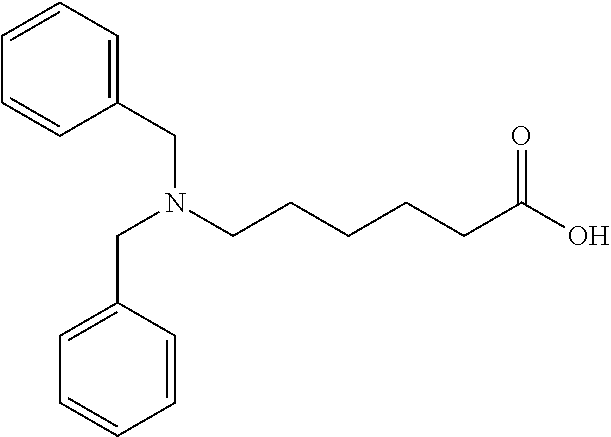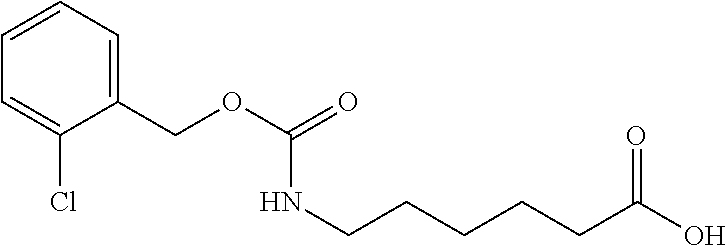Method of Making 6-Aminocaproic Acid As Active Pharmaceutical Ingredient
a technology of aminocaproic acid and active pharmaceutical ingredient, which is applied in the preparation of organic compounds, amino-carboxyl compounds, organic chemistry, etc., can solve the problems of high cost, inability to use in large-scale production, and product containment of colored impurities and odors, etc., and achieves low cost, low salt content, and low ash content
- Summary
- Abstract
- Description
- Claims
- Application Information
AI Technical Summary
Benefits of technology
Problems solved by technology
Method used
Image
Examples
example 1
(a) Preparation of 6-dibenzylamino-hexanoic acid
[0039]
[0040]5 g (44.2 mmol) of ε-caprolactam was dissolved in 23 g of 20 wt % sodium hydroxide solution and the mixture was heated to reflux for 3˜5 hours. After hydrolysis of ε-caprolactam was complete, the mixture was cooled to 5˜10° C. and then 25 g of tetrahydrofuran was added.
[0041]Under 0˜5° C., 7.88 ml of benzyl bromide was slowly added into the mixture and the mixture was allowed warm up to room temperature overnight. When the reaction was complete, 20 g of ethyl acetate was added. The aqueous layer was adjusted to pH below than 2 by 16% HCl and extracted with 25 g of ethyl acetate twice. The ethyl acetate layers were collected and then washed with brine. The organic layer was dried by sodium sulfate and concentrated to obtain 7.8 g of 6-dibenzylamino-hexanoic acid. Purity was 95.5%.
(b) Preparation of 6-aminocaproic acid
[0042]The concentrate residue was dissolved in 22 g of MeOH and 16 g of water. The mixture was reacted with 0...
example 2
(a) Preparation of 6-(2-chloro-benzyloxycarbonylamino)-hexanoic acid
[0043]
[0044]1 g (8.8 mmol) of ε-caprolactam was dissolved in 3.88 g of 20 wt % NaOH solution and heated to reflux for 3-5 hours. After ε-caprolactam was hydrolyzed completely, the mixture was cooled down to 5˜10° C. and 5 g of water was added. 1.8 g (8.8 mmol) of 2-chlorobenzyl chloroformate was added dropwise. The mixture was stirred at room temperature for an hour and washed with 15 g of ethyl acetate twice. The pH of the aqueous layer was adjusted to 1-2 by adding 16% HCl and extracted with ethyl acetate twice. Combined ethyl acetate layer was washed with brine. The organic layer was dried by sodium sulfate and concentrated to obtain 6-(2-Chloro-benzyloxycarbonylamino)-hexanoic acid. Purity was 98.9%.
(b) Preparation of 6-aminocaproic acid
[0045]The concentrate residue was dissolved in MeOH and water (3 / 1 w / w). 10% of Pd(OH)2 / C was added. The mixture was reacted at room temperature with hydrogenation at 50-60 psi. ...
example 3
(a) Preparation of 6-(4-nitro-benzyloxycarbonylamino)-hexanoic acid
[0047]
[0048]5 g (44.2 mmole) of ε-caprolactam was dissolved in 19.48 g of 20 wt % NaOH and heated to reflux for 3-5 hours. After ε-caprolactam was hydrolyzed completely, the mixture was cooled down to 5˜10° C. and then 25 g of water and 10 g of 4-nitrobenzyl chloroformate were added. The mixture was stirred 1 hour at 5-10° C. and then washed with 25 g of ethyl acetate twice. The pH of the aqueous layer was adjusted to 1-2 by adding 16% HCl and extracted with ethyl acetate twice. Combined ethyl acetate layer was washed with water. The organic layer was dried by sodium sulfate and concentrated to obtain 6-(4-nitro-benzyloxycarbonylamino)-hexanoic acid. Purity was 93.9%.
(b) Preparation of 6-aminocaproic acid
[0049]The concentrate was dissolved in 140 g of MeOH and 40 g of water. 1.3 g of Pd(OH)2 / C was added. The mixture was reacted with hydrogen at 50-60 psi at room temperature. When the reaction was complete, Pd(OH)2 / C ...
PUM
| Property | Measurement | Unit |
|---|---|---|
| Temperature | aaaaa | aaaaa |
| Time | aaaaa | aaaaa |
| Solubility (mass) | aaaaa | aaaaa |
Abstract
Description
Claims
Application Information
 Login to View More
Login to View More - R&D
- Intellectual Property
- Life Sciences
- Materials
- Tech Scout
- Unparalleled Data Quality
- Higher Quality Content
- 60% Fewer Hallucinations
Browse by: Latest US Patents, China's latest patents, Technical Efficacy Thesaurus, Application Domain, Technology Topic, Popular Technical Reports.
© 2025 PatSnap. All rights reserved.Legal|Privacy policy|Modern Slavery Act Transparency Statement|Sitemap|About US| Contact US: help@patsnap.com



